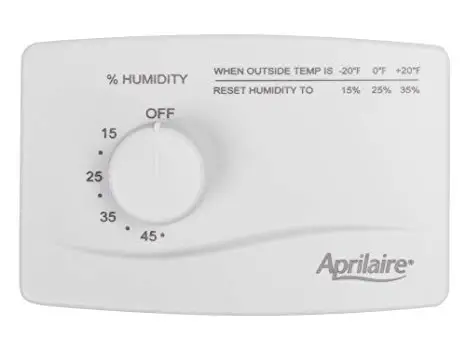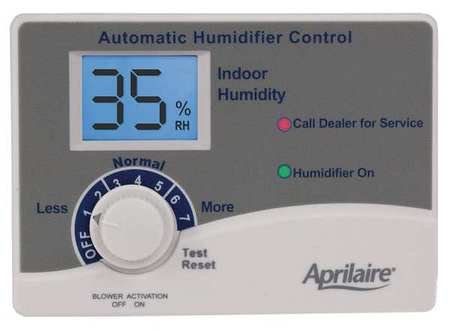
All we need to breathe and live healthily is clean, fresh, and humid air around us.
When the temperature or outdoor climate turns to be highly vulnerable, it becomes essential for you to ensure that humidity levels are maintained at a certain level. These levels should be adjusted in such a way as to make your home more comfortable and cozier to live in.
If your home lacks proper humidity levels, installing a good room humidifier is highly recommended to increase the humidity level.
Along with a good air humidifier, installing a Humidistat device to monitor and control the relative humidity levels is also very important.
It not only controls the appropriate moisture levels inside your home in an automated way, but also helps maintain these levels without worrying about weather conditions.
What is a Humidistat?
A humidistat (also called hygrostat) is a small gadget that can be easily incorporated and fitted with a humidifier with minimal effort.
It comprises two components – a sensing element and a relay amplifier.
The sensing element is made to fit into a flat plate and contains metal conductors. The relay amplifier is attached to the sensing unit and functions to read the signals sent out by the sensing elements.
Once the device is installed, the humidifier in a room can get an actual measure of relative humidity levels to control it in a better way.
Humidistat is beneficial when it’s important to maintain a particular desired humidity level, irrespective of the outdoor weather and environmental conditions.
For example, certain rooms (like your basement or bathroom) are more sensitive to humidity and may even form mildew. If you wish to control the humidity levels in these areas, you can easily fit a humidistat into the ventilation area.
How does it work?
Humidistat working principle usually employs a simple working pattern.
The conductor sets that are mounted on the sensing element will face an electrical resistance once there is a fall or variations in the moisture content.
The alternative metal conductors can eventually predict the quantity of electrical resistance by considering the relative humidity. The relay amplifier will then measure the resistance.
If the resistance has not reached the required levels, then the humidifier with humidistat is automatically turned on. And in case electrical resistance has already reached an optimum level, then the humidifier is simply turned off.
How does it benefit?
Humidistat is used to adjust the HVAC system’s valves, dampers, or other switches.
It closes down a set of electrical contacts when the humidity levels drop to a certain point, thereby turning on the humidifier to ensure effective humidity management in the atmosphere.
Other than whole-house humidifier devices that are installed into your HVAC system or with your air conditioner, humidistats are also used in stand-alone humidifiers or dehumidifiers. These often come with an easy-to-use control knob.
Presently, digital humidistats are also getting much more prevalent, in which desired humidity levels can be easily set/programmed.
This helps get a real-time update about the humidity level in a specific location or room. The humidifier is then used or adjusted depending on the readings generated by a digital humidistat.
How to Install a Humidistat Properly?
From the above, it’s clear that humidistats are powerful tools in controlling the humidity of one’s home.
However, without proper installation, you may find that your humidistat brings only minimal results.
The improper installation makes it harder to control your home’s temperature. It can also lead to extra costs if you’re not following area-specific settings.
For this reason, you must take careful steps to accurately install your home’s humidistat.
Below you will find a useful video that can help you walk through simple steps for installing your device…
Unless you have extensive experience, you may wish to consider hiring a professional installation service. These professionals can more accurately place your device for optimum results.
It’s likely that they’re already familiar with manufacturer settings and can properly install your device. This reduces the possibility of efficiency-cutting mistakes which is important.
Typically, your device will also include manufacturer recommendations that can help you tailor your settings to your area. This reduces energy costs while maximizing efficiency.
Keep in mind that by setting your humidistat device to adapt to different temperatures, you’ll be better able to control indoor humidity. Also, these settings will change based on the season and the temperature.
How to Test a Humidistat for Working?
There may be times when you find that your indoor humidity levels aren’t budging. When this happens, it’s usually the result of one or two issues: either your humidistat or your humidifier is broken.
If humidity levels aren’t changing at all, it’s likely a problem with your humidifier. You can test this by checking the voltage of your humidistat and its connection to the humidifier.
If they both return positive, it’s time to invest in humidifier repairs.
To ensure that your system is working correctly, it’s standard practice to test it following installation. This is done by running it for an entire cycle and measuring results.
If you find no change, be sure to recheck your manufacturer settings to ensure everything was followed properly.
Those who had their systems professionally installed can quickly contact the installation company. Once your system is up and running, be sure to perform routine checks for optimum performance.

What is the Best Location for a Humidistat in Home?
Those who find their devices do little to control their in-home humidity often choose an incorrect location.
What many don’t realize is that the location of their humidistat is essential, and failing to install the device in the proper location can significantly reduce its utility.
But how do you know what location to choose?
Read the instruction manual.
For example, you may want to wire your device into your thermostat. This option is common, but the specific location depends on your chosen device. For this reason, following the instruction manual is vital.
Another general rule is that your humidistat should be placed in the room that you’re trying to control the humidity of.
In other words, if you want to reduce humidity levels in your bedroom, install the device there.
Humidistat vs. Thermostat vs. Dehumidistat: The Difference?
While a Thermostat and Humidistat may sound to be a similar device to many, there is a significant essential difference between them.
Unlike a humidistat switch, the primary function of a thermostat is to monitor and control the temperature of a room (instead of humidity).
Usually attached with HVAC, thermostats are considered as the brain of these systems, which not only turns them on and off as required but also helps in controlling/maintaining the desired level of temperature inside your home.
Programmable thermostats are presently more common as they are energy efficient to help regulate the temperature in your home throughout the day and at night.
These are adjustably designed to change the indoor temperature according to your programmed settings that take effect at different time intervals.
Although a dehumidistat works similar to a humidistat, instead of closing the electrical contacts, it opens them up as soon as the humidity levels drop to a certain point.
When the relative humidity in a room increases, the electrical contacts get closed, and a dehumidistat starts working to lower the room humidity by removing the extra humidity from the air.
Unlike humidistat, dehumidistat is also used to control the ventilation of the space, which can be controlled easily with a dial knob or via digital controls.
Overall, installing a good humidistat unit OR a humidifier with built-in humidistat is undoubtedly a great way to control the humidity in your rooms all year.
Although these devices can cost you a bit more, these are worth investing in as not having it can lead to problems like too low humidity OR excessively high humidity.
Both of these can cause various health issues if left uncontrolled for long.
Do not ignore adding it if you want to give your family members the best health via optimum humidity levels inside your home or office.
Meen Smith is a nurse by profession who loves writing online, spending time with her family and caring for the elderly. She has already worked as an associate editor on various moms, babies, home appliances, kitchen, and healthy living blogs. In her spare time, she also enjoys drawing, reading/writing kindle eBooks and improving her skills a bit.
